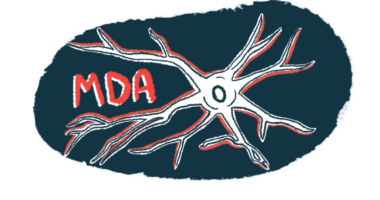Drug combination improves symptoms in SMA mouse model
AR42 protects nerve cells, while D156844 increases SMN production

An experimental oral combination of two therapies eased motor symptoms and prolonged survival in a mouse model of spinal muscular atrophy (SMA), a study shows.
The study, “The effect of coadministration of D156844 and AR42 (REC-2282) on the survival and motor phenotype of mice with spinal muscular atrophy,” was published in Scientific Reports by a trio of researchers in the U.S. AR42 is a molecule that protects nerve cells, while D156844 increases the production of the SMN protein that’s missing in SMA.
The most common types of SMA are caused by mutations in the SMN1 gene, which codes for the SMN protein, which is needed for the health and function of the nerve cells that control movement, or motor neurons. Without SMN, motor neurons die, leading to muscle weakness.
A second gene, SMN2, is very similar to SMN1 but results in only a small amount of SMN due to a slight difference in its genetic sequence. The number of SMN2 copies a patient has is generally linked to how severe the disease is, and more copies usually mean milder symptoms. Some treatments can boost the ability of SMN2 to produce more SMN.
Molecules that inhibit histone deacetylase (HDAC) enzymes can increase the activity of SMN2 in lab-grown cells. AR42 was found to protect nerve cells and ease motor symptoms in a mouse model of SMA, despite having no effect on SMN2 activity.
Testing a drug combination in SMA
Here, the researchers tested how well AR42 works with D156844, which has been shown to increase SMN levels in patient-derived cells and to extend the lifespan of mice that mimic SMA when administered before motor neurons are lost.
“This study sets the stage for a detailed analysis of the mechanisms of therapeutic success — beyond [how active SMN2 is] — thereby potentially opening the door for refinement of current strategies,” wrote the researchers, who used a mouse model of SMA that generates an unstable SMN protein to test the combination of AR42 and D156844. These mice develop progressive impairment of motor behavior that resembles what happens in the human disease. They also have a short lifespan.
When given together, AR42 plus D156844 helped the mice live almost twice as long as those given a placebo (mean, 23.7 vs. 13.9 days). This benefit was also superior relative to either drug alone.
The treatment combination also delayed a loss of body mass and led to gains in motor function, such as a shorter delay in the onset of movement and greater net movement, meaning, the number of grids the mice crossed in a minute.
The combination performed better than either molecule alone, overall. “While therapies targeting SMN2 have shown great promise in model systems as well as in clinical trials, there is still a strong need for interventions that are independent of SMN2,” wrote the researchers. They noted that, while it’s too early to know if these findings apply to people, the study shows the “potential effectiveness of multimodal therapeutic strategies” for SMA, which may also apply to “other early-onset neurodegenerative diseases.”








